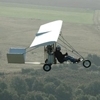Free morning - carnage time!

Basic setup: Yellow main sequence star, 3.6Msun, 6.2 million km radius, 5 rocky inner planets, 5 gas giants.

And here comes the intruder! White carbon dwarf, 800 jupiter masses, 11km radius. inclination at 87deg, perihelion at 20 million km, just skimming the roche limit of the star.

First few orbits rather uneventful, some matter exchange and reduction of eccentricity, while throwing some of the inner planets into ever more increasing inclination:

The dwarf gets pretty hot on every perihelion pass, tidal heating at 1.37E+20W. Average temp 32.000K:

System slowly getting out of shape:

Matter exchange at perihelion increasing, the blue speck on the left is the dwarf:

Due to tidal friction the orbit is getting closer, perihelion at 15 million km well inside the roche limit. Serious matter exchange:

After 182 orbits the perihelion is starting to skim the outer corona of the main star, it has lost 16% of its mass by now, the dwarf has gained 31%:

The dwarf is about to reach its chandrasekhar limit on the next pass, while the main star's stability is also edging close to core collapse:

Timing win! Core collapse of the main star, followed shortly by the dwarf. Double supernova!


Let's go to the closest planet to watch it unfold. It's 1.8 earth masses, 4.28AU from the supernovae and has an iron/nickel core and silicate crust:

Pretty, no? This type of supernova takes around 19 days to reach max luminousity which will peak around 51 billion times the luminousity of our sun. So it's all smooth sailing for now, at least until the shockwave of particles arrives. Shades are certainly recommended on the planet

Shortly before it hits:

Then the particle bombardment begins, after just 30mins the planet looks like this:

And like this after one hour:

After three hours it's just a ball of ionized plasma being completely eroded and becoming part of the plasma cloud of the supernovae:

The luminousity of the supernovae is meanwhile so high that even the furthest gas giant at 91AU is glowing bright, and the particle cloud hasn't even quite reached it yet:

View from a distance of 300AU, the four white specs are the brightly glowing outer gas giants:

View one year later from a distance of 5 lightyears, the planets are all entirely gone and the plasma cloud has a radius of about 0.7 lightyears:































